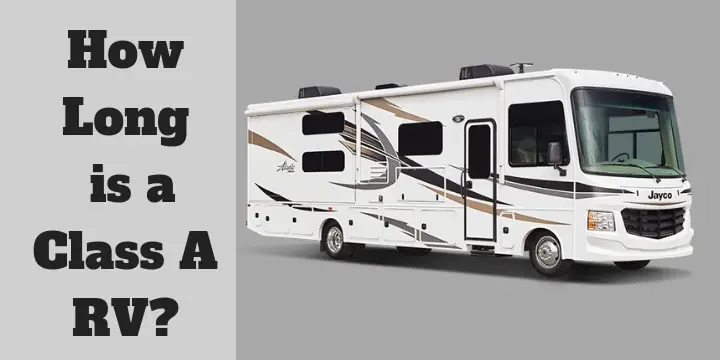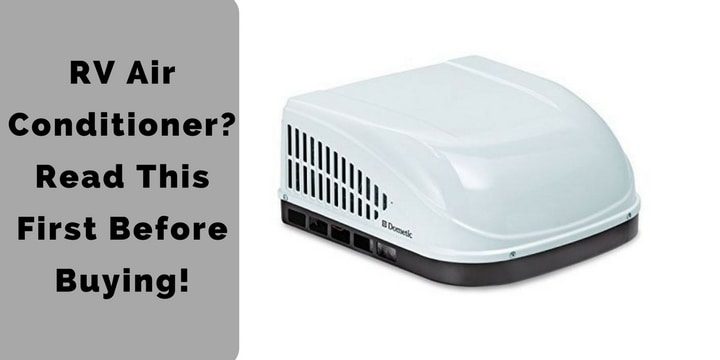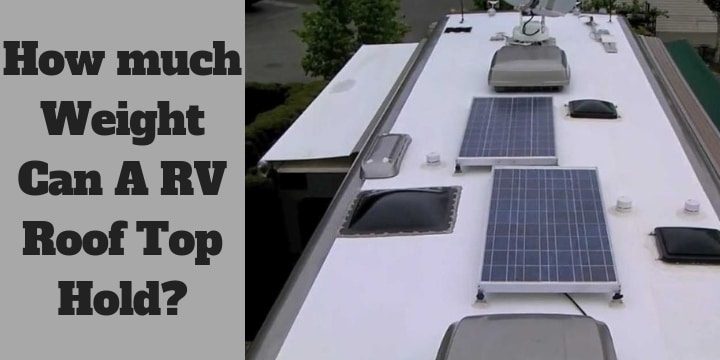How long is a class A RV?
If you buy a stripped chassis, cover it and make it a trailer so it can run down the street, then you’ll have your own crude class-A RV.
Class A RVs are considered the most ravishing of all motorhomes, sometimes having more amenities than McMansion homes.
So, the regular question comes up- How long is a class A RV? Class A can be really long -some models reaching up to an impressive 45ft length. Starting with 6.4m(21f), these top-notch RVs have advantages both of a luxurious vehicle and a self-content home.
Class A also allows its residents to have an excellent panoramic view of the outside; the roads and traffic.
What is a class A RV?
Most RVs under Class A has multiple slide-out sections which free up the living space, making the vehicle accommodate to provide you with anything from the kitchen to entertainment centers.
Why do I like Class A’s?
- Spacious Seating for drivers
- Excellent Weatherproof
- Robust Chassis and Roof Durability
- Panoramic Driver Vision
- Larger Tanks for Gas,
- Water, and every other thing
Is parking Class A RV a ‘real’ problem?
Places you can park your RV at:
Walmarts- It’s not surprising that Walmart paints its parking spots to encourage RVers to park there. Still, it’s better to park away from the entrances and customer-lining area.
Casinos- Most casinos will allow you to park your spacious RV when the spots are available. It’s not a big deal if they charge you some small fee during holidays.
You also can’t forget to stabilize your RV after leveling it while parking.
What’s your budget?
- Fuel Cost – You should already determine if you can continue with your RV’s MPG expense for a long time
- Food Cost- Prepare a well-prepared list of meals and clipping coupons that are friendly to the RV budget
- Insurance Cost – Check how much you can pay for your vehicle’s insurance monthly.
What’s your goal?
However, if you don’t want to spend hefty sum and be easier on your wallet, then class B or class C can also do the work, but with small interiors and fewer comforts.
Will you fit into National Parks?
Class A 22+ Feet:
Video Overview: RV Living RV Tour Of 22 Foot Class A Motorhome & Tip On $70 Month AT&T Unlimited Mobile Internet
22 Feet:
- 2019 Jayco Precept Prestige
- 2018 Jayco Redhawk 22J
24 Feet:
- 2018 Thor Vegas 24.1
- 2019 Forest River RV Georgetown 3 Series 24W3
- 2019 Nexus Maybach 32M
25 Feet:
- 2018 Thor Vegas 25.6
- 2019 Thor Motor Coach Axis 25.6
26 Feet:
- 2016 Fleetwood Flair
- 2016 Trek 26HMD
- 2016 Jayco Alante 26Y
27 Feet:
- 2016 Winnebago Brave 27B
- 2016 Winnebago Itasca Sunstar LX 27N
- 2016 Coachmen Pursuit 27KB
28 Feet:
- 2018 Forest River FR3 28DS
- 2014 Fleetwood Storm 28MS
- 2019 Entegra Coach Vision 26X
22 Feet:
- 2013 Thor Motor Coach ACE 27.1
- 2015 Fleetwood RV Storm 28 MS
- 2018 Jayco Alante 29S
>> You may also like: First Time Travel Trailer Owner Tips, Beginner’s Guide. <<
Class A’s 30+ Feet
Video Overview: Class A motorhome under 30ft Tour for full time living. Winnebago Vista LX 27N
30 feet
- 2018 Holiday Rambler Admiral XE 30U
- 2018 Winnebago Sunstar 29VE
- 2019 Thor Motor Coach ACE 29.3
31 feet
- 2019 Newmar Bay Star 3124
- 2018 Forest River Georgetown 31B3
- 2018 Coachmen Mirada 31FW
32 feet
- 2018 Winnebago Intent 31P
- 2017 Winnebago Vista 31B
- 2018 Coachmen Pursuit 31SB
33 feet
- 2018 Forest River Berkshire 34QS
- 2018 Thor Palazzo 37.4
- 2017 Tiffin Motorhomes Phaeton 40AH
34 feet
- 2017 Tiffin Motorhomes Allegro Open Road 32SA
- 2018 Newmar Ventana 3412
- 2018 Forrest River FR3 32DS
35 feet
- 2019 Forest River Georgetown 5 Series GT5 31L5
- 2018 Newmar Baystar 3401
- 2016 Forest River Georgetown 329DS
36 feet
- 2018 Thor Aria 3601
- 2019 Coachmen Mirada 35BH
- 2014 Itasca Sunova 35G
37 feet
- 2018 Newmar Canyon Star 3710
- 2016 Holiday Rambler Vacationer 36DBT
- 2018 Winnebago Forza 36G
38 feet
- 2017 Forest River Berkshire Cummins ISB 340HP
- 2019 Forest River RV Georgetown 5 Series 36B5
- 2018 Tiffin Allegro 36UA
39 feet
- 2015 Holiday Rambler Ambassador 38DBT
- 2015 Thor Motor Coach Outlaw M-37MD
- 2018 American Coach American Revolution LE 39B 450-HP
Video Overview: Is a 40+ Foot Motorhome Too Big For National Parks?
Class A’s 40+ Feet
Video Overview: Extreme RV 45 Foot Super C Garage Unit & Renegade Trailer
40 feet
- 2018 Thor Venetian S40
- 2017 Tiffin Motorhomes Phaeton 40 AH
- 2017 Newmar Dutch Star 4018
41 feet
- 2017 Sportscoach 407FW
- 2014 Fleetwood Discovery 40G
- 2013 Winnebago Journey 40U
42 feet
- 2013 Entegra Coach Aspire 42DLQ
- 2018 Entegra Coach Anthem 42RBQ
- 2015 American Coach Tradition 42G
43 feet
- 2018 Newmar Dutch Star 4369
- 2014 Forest River Charleston 430BH
- 2013 Entegra Coach Aspire 42DEQ
44 feet
- 2013 Fleetwood Providence 42P
- 2013 Fleetwood Discovery LXE 44B
- 2018 Holiday Rambler Endeavor 44H
45 feet
- 2016 Newmar Essex 4553
- 2016 Thor Motor Coach Tuscany 44MT
- 2016 Winnebago Grand Tour 45RL
46 feet
- 2019 Entegra Anthem 44F
- 2011 Newmar Essex 4524
49 feet
- 2012 Fleetwood Providence 42M
- 2017 Entegra Coach 44
The Bottom Line
There are a lot of different sized Class A RVs. Depending on what you’re planning to go on and how you will store your Class A will determine how long of vehicle you should buy.
5th wheel related questions
What size is a Class A RV?
Size is one of the top 5th Wheel related questions. The Class A RV is the largest Motorhome Type. Class A RV lengths vary between 26 to 46 feet. Also, Class A’s are specifically built on a chassis specially designed for motorhomes. Class B and Class C are smaller, in sizes ranging between 17 to 19 feet and 20 to 31 feet respectively.
Is it hard to drive a Class A motorhome?
Class A Motorhomes are arguably harder to drive than other RV types. The reason for this is the large size of the vehicle. Especially when driving through city streets, curvy roads and expressways, some exceptional precautions need to be taken.
The best tip is not to be overly confident or, on the contrary, exaggeratedly nervous about driving a huge Class A Motorhome. Finding the middle ground between being fearless and frightened is a good starting point.
Something to keep in mind is that most Class A Motorhomes use air-brakes. Using air-brakes is tricky: it takes you longer to stop, it takes longer for the brakes to be applied, and they are more prone to leaking than regular brakes.
Besides, Class A Motorhomes are more vulnerable to rolling over than smaller vehicles. Therefore, you will need to brake before turns. Also, you will need to avoid driving in windy or snowy conditions.
Since air brakes take longer to stop, you will need to keep proper following distance (around 4 seconds, plus one additional second for speeds above 40mph).
Another good advice is to drive somewhat slower than everybody else.
In conclusion, driving a Class A Motorhome is definitely harder than driving smaller vehicles. However, once you get the hang of it, it is immensely enjoyable.
Do I need a special license to drive a Class A RV?
It depends. Most states in the US do not require vehicles under 26,000 pounds to get a special license.
Class A RVs typically range between 13,000 to 30,000 pounds. This means only the biggest Class A Motorhomes would require a special license or a commercial driver’s license (CDL), and this only in a handful of states.
These states require non-commercial special driver’s license for vehicles over 26,000 pounds: California (or over 40 feet), Maryland, Michigan, North Carolina, Nevada, New York, Pennsylvania, South Carolina, Texas, and Wyoming.
These states require CDLs for vehicles over 26,000 pounds: Arkansas, Connecticut, Hawaii, Kansas, New Mexico, Washington D.C., Wisconsin (CDL required over 45 feet).
Can I drive a motorhome with a car license?
For the most part, yes. Very few states require drivers to get a Commercial Driver’s License (CDL) or a non-commercial driver’s license to operate a Motorhome. Click here for further specifications on every state. A safe bet here is to go for the smaller RVs –Class B and Class C– rather than the larger Class A in order to avoid the state-specific regulatory hassle.
Do Class A motorhomes have airbags?
Most Class A motorhomes do not have airbags. Mainly, it depends on the price tag. In contrast, most Class C Motorhomes do feature airbags, just like normal cars do.
>> You may also like:45 RV Accessory Must-Haves for Your Travel Trailer<<



